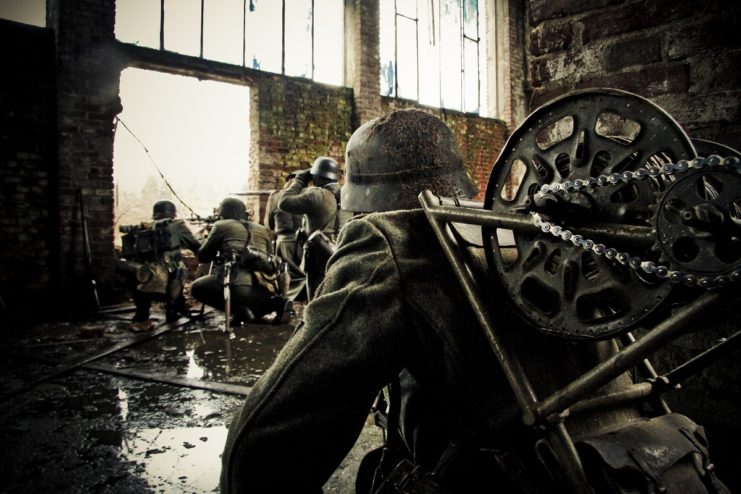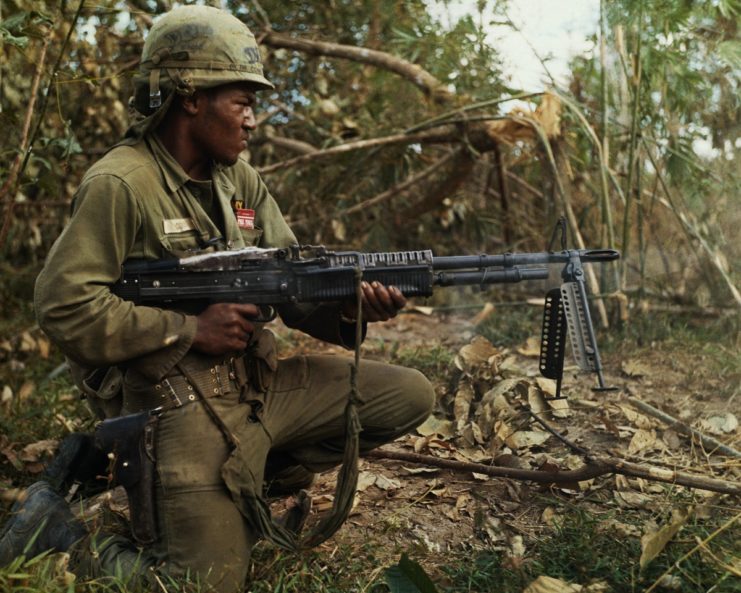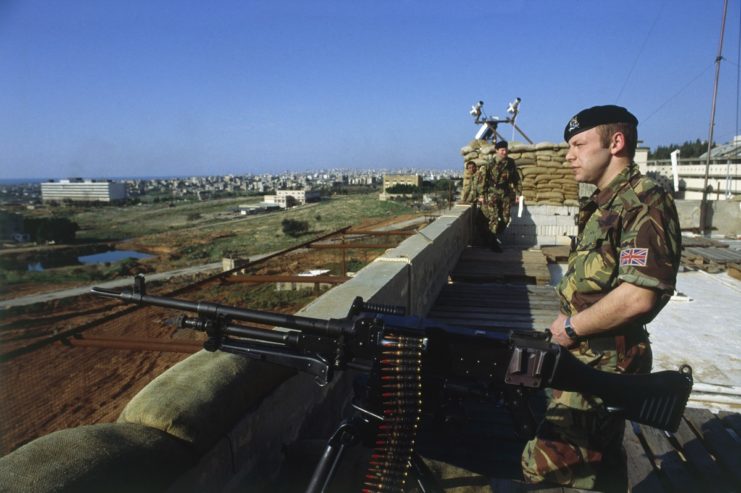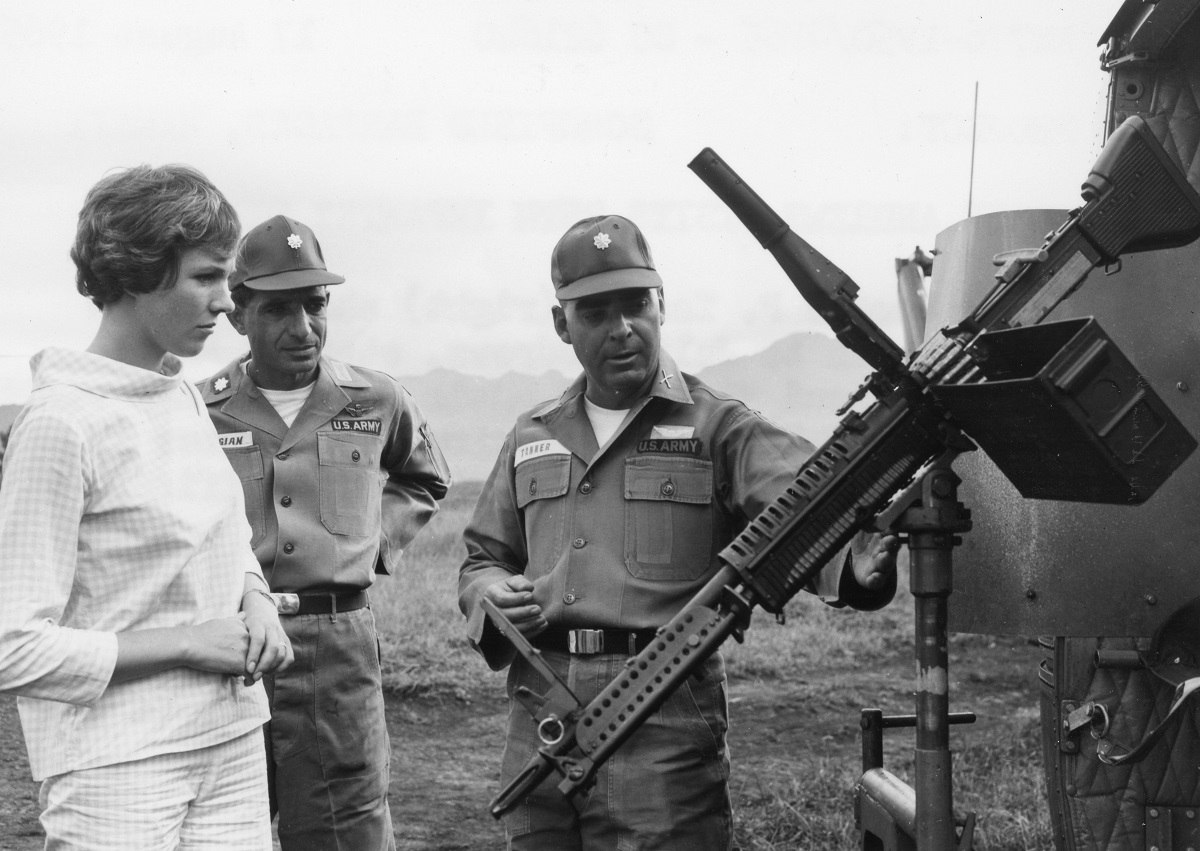The M60 machine gun is as much a symbol of the Vietnam War as the peace sign. This weapon was loved and loathed – it was a heavy load to carry, but when you were in trouble, the hard-hitting wall of fire the M60 could chuck at the enemy had your back. Found on the shoulders of troops on the ground, on the top of tanks, and in the doors of helicopters, it truly was an all-purpose machine gun.
First issued in 1959, the M60 has since been replaced in most roles by the M240 machine gun, but it is still in service and still being manufactured.
WWII influences

The MG 42 was one of the weapons that inspired the design of the M60. This powerful German machine gun was built as a cheaper and simpler version of the MG 34. It entered service in 1942 and soon became famous among its users and those it was firing upon, thanks to its insane fire rate of 1,200 rounds per minute.
This was no small-caliber weapon either, as it fired the heavy 7.92×57mm Mauser cartridge (the same round used by the German 98K rifle).
The MG 42’s rate of fire was sometimes an issue for its users as it burned through ammunition extremely quickly, but its ability to suppress an enemy force was unmatched. In terms of ergonomics, the MG 42 was lighter than comparable allied guns and easier to use.
Another technically impressive WWII German weapon was the FG 42, an advanced automatic rifle that filled a similar role as the Browning Automatic Rifle (BAR). This weapon was mostly constructed out of stamped metal, easing production, and could fire on a closed bolt during a semi-automatic fire, and on an open bolt for going fully automatic. Its stock and muzzle brake helped reduce the weapon’s climb during automatic fire.
Impressed with both of these guns, the United States looked to borrow some of their better features for use in future designs. During the war, General Motors was ordered to adapt an MG 42 to fire the .30 caliber round, but this ended in failure due to a number of errors throughout the project.
Following this, the US switched its sights to the FG 42. One of these weapons was modified with the feed tray of an MG 42 and named the T44. The weapon was simply too light for accurate, fully automatic fire though, so the T52 was made. This weapon still had many features of the FG 42 and kept the belt feed system of the MG 42, but received a heavier barrel.
Eventually, the T52 was equipped with a quick change barrel and a new, complex gas system that reduced wear on parts by venting off excess gas. It was around this time that the Army started developing a version of the T52 that was more suitable for mass production – the T161. Both weapons continued to be updated and improved, slowly morphing into the shape of the M60.
Both weapons were converted to use NATO’s new 7.62x51mm round and underwent testing. The T161 proved to be the superior choice, being 10 lbs lighter than the Browning M1919A6 machine gun and having much better ergonomics. The weapon was accepted into service in January 1957 as the M60.
The M60

It took a while for the M60 to replace its predecessors, with the first Marines in Vietnam landing in 1965 with a mix of Browning machine guns and M60s. The newer M60s were prioritized for patrol use, while the Brownings were placed on vehicles or used in base defenses. The M60 performed well in Vietnam, with its heavy 7.62 mm rounds cutting through the jungle – and people – with ease. When properly maintained, the M60 was a reliable weapon and was loved by many of its users for helping them out of sticky situations.
However, the war also highlighted a number of problems with the platform. Due to the nature of the war and the M60’s purpose, it could expect to fire thousands of rounds over the course of a single day. This continuous firing often took a toll on receivers, cracking them open. It was determined that the M60’s receiver was good for about 100,000 rounds, compared to about two million for the M240.

Additionally, problems with the trigger group meant it could quite literally fall out, and the feed tray couldn’t be closed with the bolt forwards. Also, the entire gun had to be dismounted from a firing position to change the barrel, as the bipod was attached to it. Later variants of the gun, like the M60E1 and M60E3 rectified many of these problems though, making the weapon more reliable and longer-lasting.
But by this time the M60 was being replaced by the M240.
The gun was replaced in most conventional roles by the M240, but the M60 found a new home in specialist roles, such as with US special forces. They favored the weapon as it was much lighter than the M240. The M60E4 reduced the weapon’s overlength, further increasing its portability.
Eventually, even this version of the M60 was phased out with special forces. But in the late 1990s, the M60 received another update, the M60E6. This weapon solved almost all of the previous issues with the weapon, bringing it onto an equal footing with even the very latest machine guns. In fact, the M60E6 suffered fewer failures between shots in tests than the M240.
With this version, the M60 has returned to being one of the best machine guns available today and is still a very competitive choice for any military.
